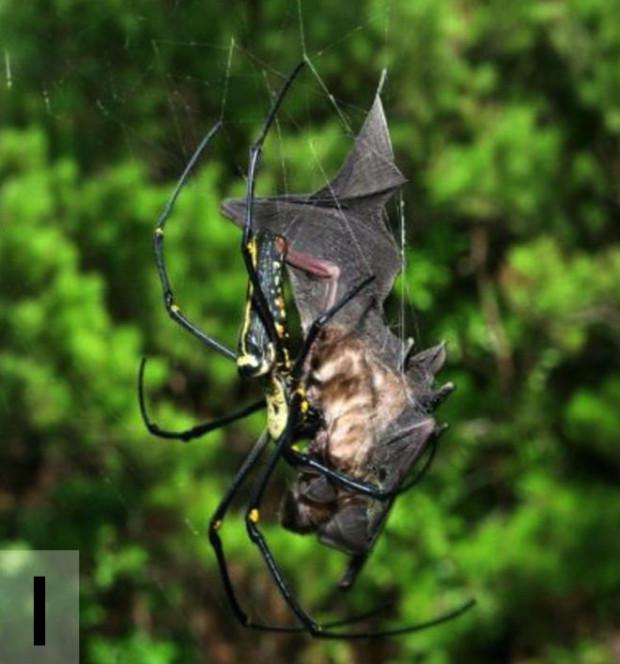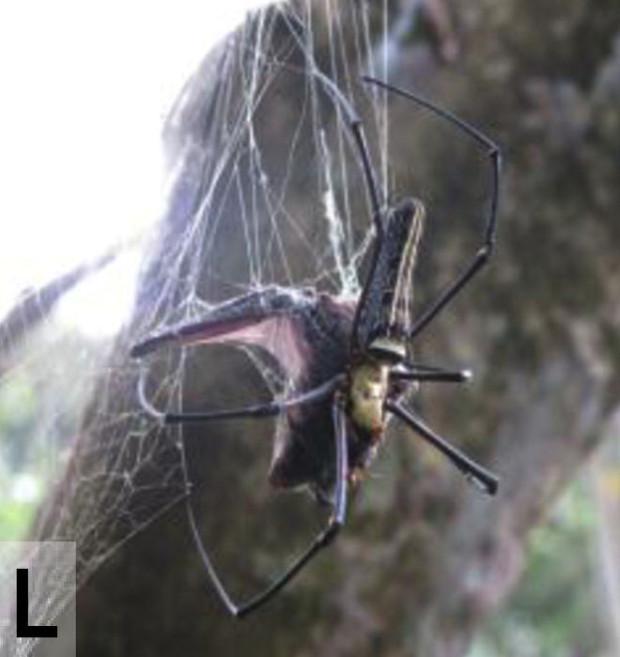903
There are spiders that feed on bats
Nervous not smotret
It is hard to imagine that a small spider can eat huge compared to him bat. But there are spiders. The catching bats makes them extraordinarily durable Wide Web.
Neffler Martin of the University of Basel (Switzerland) and Miriam Knornsshild from the University of Ulm (Germany) has recently conducted a study to find out how often the spiders prey on bats. The studies they found 52 unrelated report on spiders caught bats.

Such stories have occurred on every continent except, for obvious reasons, Antarctica. Today it is well known that 90% of these spiders live in warm areas - near the equator or along the Tropics of Cancer and Capricorn. About 40% of spiders are found in South America and the tropical regions of North America. Another 30% live in Asia, and the rest - in Australia and Papua New Guinea.
All spiders are quite large: swing the legs from 10 to 15 cm and a weight of one to six grams. Most spiders weave a cobweb at night, their networks reach up to 1, 5 meters in diameter. Sometimes spiders get off in groups and spin somewhat related to each other networks. Most of these networks have been found near the colonies of bats.

Only 12% of spiders can catch the bat at all without the help of the web. In this example, are able to live in the rainforests of Peru, Ecuador and Brazil tarantulas. Sami mouse is quite small: a wingspan of 10 to 24 cm, and weight - from three to seven grams. Most mice victims - cubs. They usually fall into the web and die from starvation, dehydration or themselves cause self-injury in an attempt to break free.

But few such cases. Bats fall into the web not so often - they avoid it by using echolocation. Single Wide Web are hard to find, but a large joint web - is easier. And although able to kill spiders and bats, they may be saved from it. The natural balance.






via factroom.ru

It is hard to imagine that a small spider can eat huge compared to him bat. But there are spiders. The catching bats makes them extraordinarily durable Wide Web.
Neffler Martin of the University of Basel (Switzerland) and Miriam Knornsshild from the University of Ulm (Germany) has recently conducted a study to find out how often the spiders prey on bats. The studies they found 52 unrelated report on spiders caught bats.

Such stories have occurred on every continent except, for obvious reasons, Antarctica. Today it is well known that 90% of these spiders live in warm areas - near the equator or along the Tropics of Cancer and Capricorn. About 40% of spiders are found in South America and the tropical regions of North America. Another 30% live in Asia, and the rest - in Australia and Papua New Guinea.
All spiders are quite large: swing the legs from 10 to 15 cm and a weight of one to six grams. Most spiders weave a cobweb at night, their networks reach up to 1, 5 meters in diameter. Sometimes spiders get off in groups and spin somewhat related to each other networks. Most of these networks have been found near the colonies of bats.

Only 12% of spiders can catch the bat at all without the help of the web. In this example, are able to live in the rainforests of Peru, Ecuador and Brazil tarantulas. Sami mouse is quite small: a wingspan of 10 to 24 cm, and weight - from three to seven grams. Most mice victims - cubs. They usually fall into the web and die from starvation, dehydration or themselves cause self-injury in an attempt to break free.

But few such cases. Bats fall into the web not so often - they avoid it by using echolocation. Single Wide Web are hard to find, but a large joint web - is easier. And although able to kill spiders and bats, they may be saved from it. The natural balance.






via factroom.ru
In Azerbaijan, there is a mountain, which burns an eternal flame
«Aston Martin» Daniel Craig has promised to provide free cars at any time before the end of life























